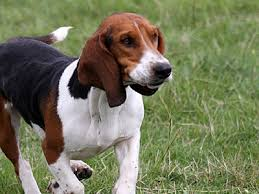American Foxhound

Description
Various importations of English Foxhounds took place in the 1700s and these formed the basis for breeding programs in America that gradually changed the original foxhound type to a smaller, finer hound than the English counterpart. Further importations from throughout the British Isles and France occurred during the 1800s, including the importation of English dogs crossed with a Tennessee dog to produce the Walker hound strain.
The Irish imports gave rise to the Trigg and Henry-Birdsong strains. There are a handful of other strains that developed in different regions. Most foxhounds are registered with the International Foxhunter Studbook as opposed to AKC and other breed registries.
Breeding for Function
Over the years, four different hound subtypes were bred to account for differences in their functions in the hunt.
- Drag hounds that are raced on a drag scent where speed is the sole winning factor
- Field trial hounds where speed and competitiveness are essential.
- Fox hunters that work with an on-foot hunter with gun.
- Pack hounds; the traditional hunt club function.
Even today, only rarely are these dogs kept for companionship or for show purposes.
Group
Hound Group
Country Of Origin
USA
Size
Color
Coat
Hard, medium length coat lays flat and any color is accepted. Tricolors (white, tan and black) are the most common.
Grooming
Brush weekly.
Life Expectancy
11-14 years
AKC Group
UKC Group
Scenthound
Height
- Female 21-24" (53-61 cm)
- Male 22-25" (56-63.5 cm)
Weight
65-75 lb (30-34 kg) in the standard, but some are smaller.
Use Today
Points Of Conformation
These dogs typify a dog of moderate proportions. The skull is long and slightly domed, ears are set moderately low, and are long and pendulous with fine leather, and have rounded tips. Wide set eyes are large and brown or hazel in color. The muzzle is square, and a moderate stop is present. The neck is medium in length and not throaty. Thorax is deep and narrower than the English type, ribs are well sprung and rib cage extends well back. The back is long and level though slightly arched. The limbs are straight, feet are compact with well-arched toes. The tail is carried gaily and curved, with a slight brush at the tip.
Recognized Behavior Issues and Traits
Reported breed attributes include: Friendly disposition, very active, low grooming needs. They are not suitable for guarding or watchdog. May run off, so should only be off leash in a fenced enclosure. Gets along well with other dogs and as pets, they are amicable. Good with children and around the house as long as they are raised as house pets; not kenneled.
Not considered an apartment dog. They have high exercise requirements. One needs to start obedience training early because of possible independent streaks.
Normal Physiologic Variations
Pelger-Huet Anomaly: Autosomal recessive inherited blood anomaly causing neutrophils with round, oval, or bean-shaped nuclei and only rare segmented nuclei. No obvious effects of disease seen in affected dogs.
Inherited Diseases
Hip Dysplasia: Polygenically inherited trait causing degenerative joint disease and hip arthritis. Too few American Foxhounds have been screened by OFA to determine an accurate frequency.
Elbow Dysplasia: Polygenically inherited trait causing elbow arthritis. Too few American Foxhounds have been screened by OFA to determine an accurate frequency.
Patella Luxation: Polygenically inherited laxity of patellar ligaments, causing luxation, lameness, and later degenerative joint disease. Treat surgically if causing clinical signs. Too few American Foxhounds have been screened by OFA to determine an accurate frequency.
Disease Predispositions
Hypothyroidism: Inherited autoimmune thyroiditis. 9.3% positive for thyroid auto-antibodies based on testing at Michigan State University. (Ave. for all breeds is 7.5%).
Leishmaniasis: This infectious disease is primarily only diagnosed in Foxhounds. Research suggests vertical transmission (mother to offspring), though a genetic susceptibility cannot be ruled out.5,6,7,8 Deafness: Congenital deafness can be unilateral or bilateral. Diagnosed by BAER testing.
Ocular Disorders: Too few American Foxhounds have been CERF examined to determine the frequency of ocular disorders in the breed.
Cricopharyngeal dysphagia, Cryptorchidism, Hound ataxia, and Thrombopathia are reported.
Genetic Tests
Tests of Genotype: Direct tests for coat color alleles are available from VetGen.
Tests of Phenotype: Recommend hip and elbow radiographs, thyroid profile including autoantibodies, CERF eye examination, patella evaluation and cardiac evaluation
Miscellaneous
- Breed name synonyms: Foxhound
- Registries: AKC, UKC, CKC, KCGB (Kennel Club of Great Britain), NKC (National Kennel Club)
- AKC rank (year 2008): 158 (17 dogs registered)
- Internet resources: American Foxhound Club Inc.: americanfoxhoundclub.com
Masters of Foxhounds Association of America: mfha.com
The Foxhound Club of North America: fcna.org